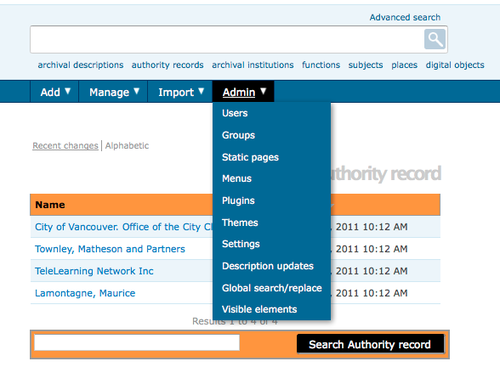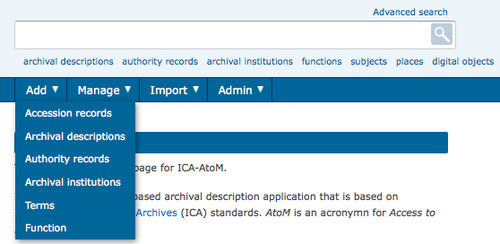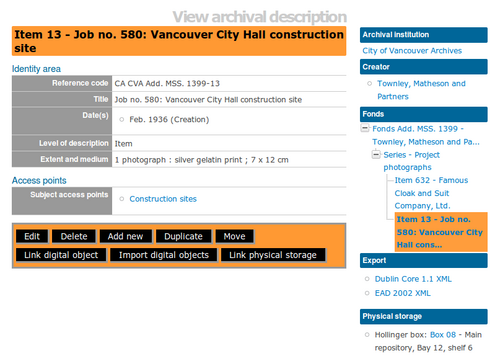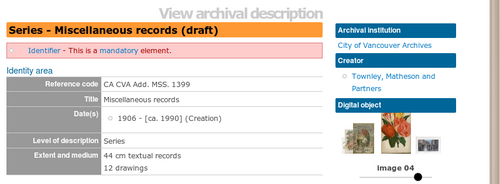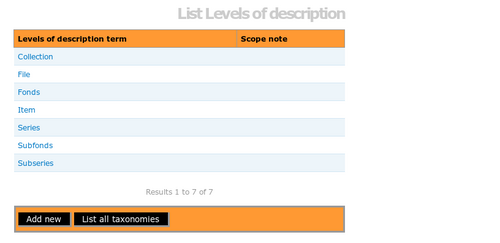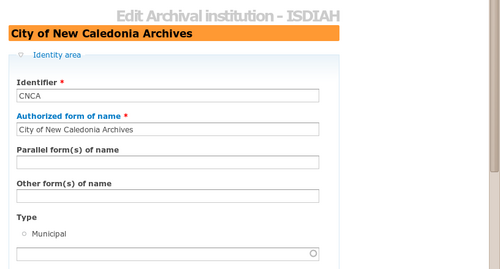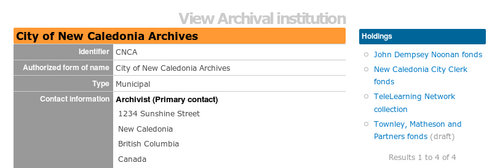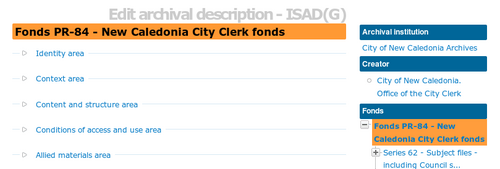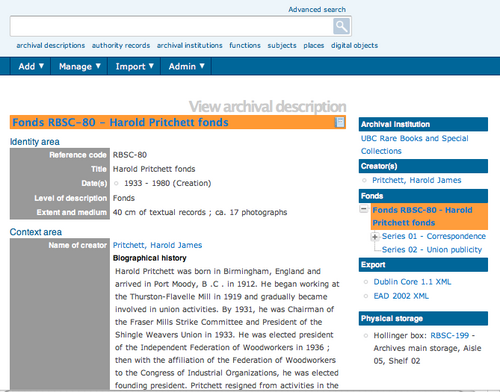Difference between revisions of "Glossary/fr"
| Line 106: | Line 106: | ||
<div class="clearfix"> | <div class="clearfix"> | ||
| − | == | + | == En-tête de colonne == |
| − | [[Image:columnHeader.png|500px|right|thumb| | + | [[Image:columnHeader.png|500px|right|thumb|En-tête de colonne (la barre orange en haut de la liste)]] |
| − | + | Les en-têtes de colonnes apparaissent en haut des pages de listes et de [[Page types/fr|navigation de résultats]] et donnent le nom du [[#Champ|champ]] pour tout ce qui est en-dessous. | |
</div> | </div> | ||
Revision as of 03:38, 14 October 2011
Please note that ICA-AtoM is no longer actively supported by Artefactual Systems.
Visit https://www.accesstomemory.org for information about AtoM, the currently supported version.
Cette page donne des définitions de termes utilisés dans le système et la documentation utilisateurs d'ICA-AtoM .
Administrateur
L'administrateur est un type d'utilisateur qui a des droits d'accès pour les actions suivantes : installer ou désinstaller ICA-AtoM ; créer, lire, mettre à jour ou supprimer toute notice ; adapter ICA-AtoM aux besoins propres à l'institution ; et gérer les comptes utilisateurs et les profils utilisateurs (voir Rôles utilisateurs et Administrer).
Bouton Créer
Le bouton Créer est localisé dans la barre de boutons de la page de consultation et permet aux utilisateurs de créer de nouvelles notices dans ICA-AtoM : (descriptions archivistiques, notices d'autorité, services d'archives, et termes).
Description archivistique
Une description archivistique est un ensemble d'informations sur un ou des documents d'archives. Les descriptions donnent des informations contextuelles sur les documents d'archives et sont organisées en niveaux hiérarchiques (fonds, séries, dossiers, pièces, et des variantes de ces niveaux en conformité avec les normes des institutions). Dans ICA-AtoM, les éléments de données utilisés pour décrire les documents d'archives sont dérivés de la Norme générale internationale de description archivistique de l'ICA (ISAD). Voir Types d'entité et Créer/modifier des descriptions archivistiques.
Droit d'accès
Les droits d'accès contrôlent les moyens permettant à un utilisateur d'interagir avec ICA-AtoM. Par exemple, des utilisateurs peuvent créer et modifier le contenu tandis que d'autres peuvent seulement interroger et parcourir le contenu. Les droits d'accès sont basés sur des rôles utilisateurs définis (voir Rôles utilisateurs).
Menu Administrer
Le menu administrer permet aux utilisateurs ayant un accès administrateur d'adapter ICA-AtoM pour répondre aux besoins propres à leur institution et de gérer les comptes utilisateurs et les profils utilisateurs (voir Administrer).
Menu Créer
Le menu "Créer" permet aux utilisateurs autorisés de créer des descriptions archivistiques, des notices d'autorité, des services d'archives, des termes, et des fonctions. Seuls les utilisateurs qui se sont identifiés peuvent afficher le menu "Créer".
Page A propos
La page A propos donne des informations générales sur ICA-AtoM. Elle peut être atteinte via le menu utilisateur dans le coin supérieur droit de la page. Le contenu de la page A propos peut être modifié par les administrateurs (voir Gérer les pages statiques).
Point d'accès
Un point d'accès est un "nom, mot-clé, entrée d'index, etc., permettant de rechercher et de retrouver une description." (glossaire ISAD). Dans ICA-AtoM, les points d'accès sont dérivés des notices d'autorité et des taxonomies créées et adaptées par les utilisateurs. Voir Créer/modifier des termes.
Service d'archives
Un service d'archives est "un organisme qui détient et préserve des documents d’archives et les rend accessibles au public." (glossaire de la norme ISDIAH). Dans ICA-AtoM, les éléments de données utilisés pour décrire ces institutions sont basés sur la Norme internationale de l'ICA pour la description des institutions de conservation des archives (ISDIAH). Voir Types d'entités et Créer/modifier des services d'archives.
Unité archivistique
Une unité archivistique est un terme générique pour un ensemble de documents d'archives. Une unité peut être un fonds, une série organique, un dossier, une pièce, ou une variante, dépendant des normes institutionnelles. Une unité peut être subdivisée en sous-unités pour les besoins de la description : par exemple un fonds peut contenir plusieurs séries, chacune pouvant contenir plusieurs dossiers, et ainsi de suite. L'unité la plus petite (et donc indivisible) est la pièce.
Notice d'autorité
Dans ICA-AtoM, les notices d'autorité sont des ensembles d'informations sur des acteurs - collectivités, personnes ou familles - qui interagissent avec les documents d'archives, habituellement comme producteurs. Les éléments de données utilisés pour décrire des notices d'autorité sont basés sur la Norme internationale de l'ICA pour les notices d'autorité (Collectivités, personnes, familles) (ISAAR). ISAAR définit la notice d'autorité comme "la forme autorisée du nom d’une entité associée à des éléments d’information qui permettent d’identifier et de décrire cette entité, et qui peuvent la mettre en relation avec d’autres notices d’autorité." Voir Types d'entité et Créer/modifier des notices d'autorité.
La navigation permet à un utilisateur d'afficher toutes les notices comportant un certain type de point d'accès (par exemple mot-matière, nom propre, ou nom de lieu) ou tout autre type de filtrage de la recherche, comme type de support ou type d'entité. Dans le thème par défaut d'ICA-AtoM (le thème Caribou), le menu de navigation apparaît dans une ligne horizontale sous la lucarne de recherche; dans les thèmes Alouette et Columbia, le menu de navigation s'affiche dans une boîte verticale au-dessus et à droite de la lucarne de recherche.
Barre de boutons
La barre de boutons permet aux utilisateurs ayant les droits de créer ou de supprimer des contenus ou de refuser les changements apportés dans les formulaires.
Notice enfant
Une notice enfant se rapporte à une description de l'unité archivistique qui est à un niveau de description subordonné à celui de l'unité en cours de description, par exemple si une série appartient à un fonds, la notice descriptive de la série est la notice enfant de la notice du fonds.
Collection
Dans ISAD, une collection est une "réunion artificielle de documents en fonction de critères communs liés à leur contenu ou à leur support, sans considération de leur provenance, par opposition au fonds d'archives constitué de façon organique." Dans les Règles pour la description des documents d'archives, c'est "[un] regroupement de documents de toute provenance, rassemblés intentionnellement en fonction d'une caractéristique commune." Dans Dublin Core, une collection est "[un] agrégat de ressources. Une collection est décrite comme un regroupement ; ses composantes doivent également être décrites séparément."
En-tête de colonne
Les en-têtes de colonnes apparaissent en haut des pages de listes et de navigation de résultats et donnent le nom du champ pour tout ce qui est en-dessous.
The context menu appears on all view and edit pages to show the current record's relationships to other records, with links, e.g. they show the hierarchical placement of archival descriptions within a fonds and the relationship between archival institutions, authority records, and archival holdings. See Context menu.
Contributor
A contributor is a type of user who can search, browse, create, and edit descriptions. See User roles.
Controlled vocabulary
A controlled vocabulary is a set of pre-defined, authorized terms grouped into taxonomies or entered into authority records and used for generating value lists and access points. See Add/edit terms.
Cover flow
Cover flow show sets of thumbnails of digital objects and allows the user to scroll through the thumbnails using a mouse or keyboard scroll arrows. In ICA-AtoM a cover flow viewer appears in the context menu of archival descriptions whenever there are associated lower-level descriptions that have digital objects attached.
Create button
The create button, located on the button block, is used to save new entities. Once an entity has been saved for the first time, the create button disappears and is replaced by the "Save" button, which is used to save all subsequent changes.
Creator
A creator is "Any entity (corporate body, family or person) that created, accumulated and/or maintained records in the conduct of personal or corporate activity" (ISAAR glossary). In ICA-AtoM, the creator is described in an authority record linked to an archival description, usually at the highest level of description only. Lower levels inherit the creator from the parent record, unless a different creator is specified. ICA-AtoM can accommodate multiple creators at all levels of description. See Context area.
Current language
Refers to the language in which the user interface elements and database content are displayed. Users can switch between languages by using the language menu.
Data element
Data elements, or elements of description, are ICA standards-based units of information applied to archival descriptions, authority records, archival institutions, and terms. The elements are entered into fields in ICA-AtoM's edit pages.
Database content
Database content refers to information stored in ICA-Atom's database tables, including data elements, static page content, and user profile information.
Default content
Default content is any database content that is included by default when ICA-AtoM is installed. This includes things like the default home page and drop-down menu values that are stored in taxonomies.
Default language
The default language is the language in which all user interface elements are displayed when ICA-AtoM is opened. The language is specified when the application is installed. Users can switch to other supported languages and translators can translate database content and user interface elements. See Choose language and Translate.
Delete button
The delete button appears in the button block. Clicking on the delete button will prompt a warning to appear asking whether the user really intends to delete the entity.
Delete icon
Delete icons are small buttons in edit pages used to delete values from multi-value fields, such as those containing event dates or access points.
Développeur
Un développeur est un programmeur qui peut modifier le code source d'une application ICA-AtoM. Dans la version beta d'ICA-AtoM (1.0.9), beaucoup d'adaptations de l'application peuvent être faites seulement par les développeurs. Dans de futures versions du logiciel, de plus en plus de fonctionnalités seront adaptables via les éléments de l'interface utilisateur disponibles pour les administrateurs.
Digital object
Digital objects are computer files that can be uploaded into and displayed by ICA-AtoM. They include scanned images, digital photographs, sound and moving image files, and other scanned or born-digital items. See Upload digital objects and File formats.
Draft record
A draft record is an archival description that has not been published. All new and imported archival descriptions have draft status until the user changes that status to published in the gray box at the bottom of the archival description edit page.
The status is inherited from the highest level of description. Users who are not authenticated cannot view draft records.
A drop-down list menu is a list of data-entry options that appears below certain fields in edit pages. Values are drawn from controlled-vocabulary terms, authority records, and default data contained in ICA-AtoM's database tables.
Edit button
The edit button appears at the bottom of view pages; clicking the button takes the user to the edit page for that record.
The user can also switch between view and edit pages by clicking the title bar.
Edit icon
The edit icon appears in edit pages next to fields that derive data from a related record. The user clicks the icon to edit the text in the related record, e.g. to edit the "Administrative/biographical history" in an archival description, the user must click the edit icon because the data resides in the creator's authority record.
Edit mode
Edit mode allows the user to add, modify, or delete the contents of archival descriptions, authority records, archival institutions, terms, and other database content using edit pages. In edit mode, ICA-AtoM displays all fields in a record for data entry.
Edit page
Edit pages allow users to add, edit and delete the contents of archival descriptions, authority records, archival institutions, functions and terms. They are also used to carry out administrative functions such as changing user profiles and editing static pages.
Editor
An editor is a type of user who can search, browse, add, edit and delete archival descriptions, authority records, archival institutions, functions and terms. See User roles.
Entity
An entity is an object about which an information system collects data. From the user's perspective, in ICA-AtoM there are four main entities: archival descriptions, authority records, archival institutions, and terms. See Entity types.
Error message
An error message will display when ICA-AtoM is unable to execute an action. See error for examples of types of error messages.
Event
In ICA-AtoM, an event registers an action by an actor (corporate body, person, or family) at a particular time or over a span of time and may establish a relationship between the actor and other actors or entities. This is accomplished through the use of start and end dates in the context area of the archival description, which links the creator or other actor to the records for the period of time delimited by the dates. See Entity types and context area.
Field
A field is a container for a data element. Content is added to or modified in fields in edit pages.
Field label
Field labels identify fields in view pages and edit pages. In ICA-AtoM 1.0 beta, field labels can only be customized by developers working directly with the code; in a future release an interface for customizing labels will be available to administrators.
Fonds
Fonds is an archival unit defined as "The whole of the records, regardless of form or medium, organically created and/or accumulated and used by a particular person, family, or corporate body in the course of that creator's activities and functions." (ISAD glossary). In ICA-AtoM, the fonds is by default the highest level of description. This default can be changed by administrators (see User interface labels).
Function
A function is a type of entity that describes activities linked to records creation, maintenance and use. Functions in ICA-AtoM are linked to archival descriptions, authority records and other functions. In ICA-AtoM the fields for describing functions are taken from the ICA's International Standard for Describing Functions (ISDF). See Entity types.
Holdings
Holdings is a generic term referring to the records and other materials held by archival institutions. In ICA-AtoM a list of holdings is displayed in the context menu on archival institution view pages. The list is generated from the titles of archival descriptions that have the archival institution selected as a repository (see Context area).
Home page
The home page is the first page the user sees when opening the ICA-AtoM application. It can also be accessed via the "Home" link on the user menu or by clicking the site logo. The content of the home page can be edited by administrators (see Manage static pages).
Information area
Information areas appear on edit pages and group related fields based on the organization of elements of description in ICA descriptive standards. Clicking on an information area toggles it between closed (all fields in that area hidden) and open (all fields visible).
The language menu, located in the top-left corner of the page, allows the user to switch to any of the supported languages in ICA-AtoM. The current language is always underlined. See Choose language.
Level of description
The level of description is "the position of the unit of description in the hierarchy of the fonds" (ISAD glossary). In ICA-AtoM, the level of description is selected from a value list in the "Identity" area of an archival description. See Identity area.
The main menu is the the navigational tool located near the top of all pages for authenticated users, right below the search box. It allows the user to navigate to all the main areas of ICA-AtoM.
Master digital object
The master digital object is the unaltered version of a digital object that has been uploaded to ICA-AtoM. ICA-AtoM automatically generates a thumbnail and a reference display copy of the object. Only authenticated users may view master digital objects. See Upload digital objects.
Media type
Media type refers to the format of uploaded digital objects. The media type is selected automatically by ICA-AtoM when a digital object is uploaded and the thumbnail and reference display copies of the object are generated. See Upload digital objects.
Media type terms are controlled by the media type taxonomy. ICA-AtoM ships with five terms (audio, image, text, video, other) that are locked; these cannot be edited or deleted because they are referenced by ICA-AtoM's code. Editors and administrators can add new media type terms, but unless developers incorporate these into the code, the system will not be able to do anything with them.
Multi-repository system
A multi-repository system exists when a single instance of ICA-AtoM is used by a network of archival institutions.
Multi-value field
A multi-value field is a field that is structured to contain more than one data entry.
Name
In ICA-AtoM, names are registered in authority records for corporate bodies, persons, and families who interact with archival materials as e.g. creators, custodians and publishers. Names can be applied as access points to archival descriptions. See access points.
Network
A network is an aggregation of institutions using one instance of ICA-AtoM to produce a union list of archival holdings (a multi-repository system).
Page title
The page title indicates what kind of page a user is viewing; for example, it indicates whether archival descriptions, authority records or archival institutions are being displayed in a view page or an edit page.
Parent record
The parent record refers to the description of the archival unit that is one level of description higher than the current unit. For example, a fonds may be the parent record of a series.
Password
Passwords are required by every user of the system who needs to be able to add, edit, or delete content. The initial passwords are set by the system administrator (see add a new user) and can subsequently be changed by the user (see Change password).
Place
In ICA-AtoM, a place is a geographic location registered in a taxonomy and used as an access point in archival descriptions, authority records, and archival institutions.
Physical storage
Physical storage is a grouping of fields relating to the management of physical objects such as folders, boxes, shelves, and cabinets. In ICA-AtoM, users can create and edit information about physical objects by clicking on the "Link physical storage" button in the button block of an archival description. See Physical storage.
Published record
A published record is an archival description that has had its status changed from draft to published in the gray box at the bottom of the archival description edit page.
The status is inherited from the highest level of description; e.g. when a fonds description is changed from draft to published, all child records within the fonds are automatically changed as well. Once archival descriptions have been published, users who are not logged in can view them.
Reference display copy
A reference display copy is a low-resolution version of a master digital object generated automatically by ICA-AtoM on upload. It is used to display images on the digital object view page when the user clicks on a thumbnail and in the digital object area of edit pages. See Upload digital objects.
Researcher
A researcher is a type of user who is limited to searching and browsing descriptions. See User roles.
Search box
The search box is used to find descriptions in ICA-AtoM that contain text matching a search query. The search box is located over the main menu on all ICA-AtoM pages, including the home page. See Access content.
Setting
Settings is a broad term used to describe the properties that affect the way a program looks and functions. In ICA-AtoM, certain settings can be changed by an administrator in order to customize ICA-AtoM to institution-specific requirements. See Settings.
Site description

The site description appears at the top of the page directly under the site title. It is a configurable element - the text can be changed or removed (see Themes).
Site logo
The site logo is the graphic that appears at the top of all pages in ICA-AtoM. Clicking on the logo will take the user to the home page. ICA-AtoM ships with a default logo that can be replaced by administrators to theme the application to their own institution or network if desired: see Site logo.
Site title

The site title appears at the top of the page next to the site logo and over the site description. It is a configurable element - the text can be changed or removed (see Themes).
Static page
Static pages are pages that are designed to look the same each time they are accessed, in contrast to dynamic pages such as search results, view pages, or edit pages. ICA-AtoM has two static pages, the home page and the about page. Static pages can be edited by an administrator (see Manage static pages).
Subject
In ICA-AtoM, subjects are controlled-vocabulary terms grouped in a taxonomy and used as access points in archival descriptions.
Supported language
In ICA-AtoM, a supported language is one into which both data elements and user interface elements can be translated. In ICA-AtoM version 1.0 beta, the supported languages are Arabic, Dutch, English, Farsi, French, German, Greek, Icelandic, Italian, Japanese, Korean, Portuguese, Spanish and Slovenian.
Taxonomy
A taxonomy is a grouping of controlled-vocabulary terms used to generate value lists and access points. See Add/edit terms.
Term
Terms are the values that make up controlled vocabularies. In ICA-AtoM, terms are grouped into taxonomies that can be added, edited, and deleted through the "Term" item of the add menu. See Add/edit terms.
Thumbnail
A thumbnail is a small, low-resolution version of a master digital object generated automatically by ICA-AtoM on upload. Thumbnails are displayed in search and browse results and in cover flow views at higher levels of description. See Upload digital objects.
Title bar
The title appears at the top of archival descriptions, authority records, and archival institutions and functions.
Tooltips
Tooltips are online text designed to assist users to enter data in edit pages. Tooltip text is derived from the standards on which the edit templates are based. Note that administrators can tooltips on or off - see Global settings.
Translation bar
The translation bar appears at the bottom of the page when users with translator access privileges select a language from the language menu. Clicking on "Translate user interface" in the bottom right-hand corner of the bar opens up the translation panel, where the user translates user interface elements. See Translate interface.
Translation panel
The translation panel is used by translators to edit user interface elements and is accessed via the translation bar. See Translate interface.
Translator
A translator is a type of user who can translate data elements and user interface elements. See User roles.
User account
User accounts are established in order to manage access privileges through the assignment of user roles. Every user who must be able to add, edit, delete, or translate content must have a user account. In ICA-AtoM user accounts are established and maintained by administrators. See Manage user accounts.
User interface
The user interface is the set of elements that allow the user to interact with the ICA-AtoM application. These elements include the main menu, drop-down menus, context menu, title bar, column headers, buttons, fields, and field labels, and any other elements used to navigate ICA-AtoM or to search for, view, add, edit, and delete database content. The labels of some user interface elements can be customized by administrators (see User interface labels).
The user menu, located in the upper right hand corner of the page, contains basic navigational links. These allow the user to go to the home page and about page, user documentation (help pages) and the log in page. Authenticated users can also use it to navigate to their user profiles.
Username
The username is a name supplied by an administrator to any user (other than a researcher) of the ICA-AtoM application as part of the user account. See Manage user accounts.
User profile
A user profile is information about a user managed in a user account. User profiles are created and maintained by administrators (see manage user accounts), although authenticated users can view their own profiles (and change their passwords) by going through the user menu.
User role
User roles define levels of access to functions in ICA-AtoM, ranging from view-only access to full administration rights. User roles are defined by groups that an administrator can add and edit. See User roles and Add a new group.
Value list
Value lists restrict data entry in certain fields to controlled vocabulary terms or terms derived from authority records. They appear as drop-down menus in edit pages.
View mode
View mode provides read-only access to the contents of archival descriptions, authority records, functions and archival institutions using view pages. In view mode, ICA-AtoM displays only those fields in a record which contain data.
View page
View pages allow users to view in detail the contents of archival descriptions, authority records, archival institutions, and functions

